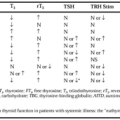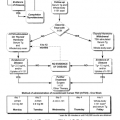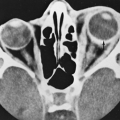SPECIFIC ETIOLOGIES OF GOITER
Part of “CHAPTER 38 – NONTOXIC GOITER“
CONGENITAL GOITER
Congenital goiter is either familial—that is, an expression of genetic disorders of intrathyroidal hormonogenesis (see Chap. 47)—or sporadic. In the neonate, sporadic congenital goiter reflects intrauterine iodide insufficiency or fetal exposure to goitrogens. Maternal consumption of naturally occurring goitrogens is rarely the cause of thyroid enlargement in the neonate; this contrasts with endemic goiter, in which community-wide ingestion of a goitrogen occurs. Use of antithyroid medications is a significant cause of sporadic congenital goiter (i.e., thionamide administration to pregnant thyrotoxic women). Thionamides cross the placental barrier and limit fetal hormonogenesis after the 12th week of gestation. The requisites for such a congenital goiter include fetal TSH production, maturation of the
fetal thyroid to the point of TSH responsiveness, and sensitivity of the pituitary to low levels of thyroid hormone. Because insubstantial quantities of maternal thyroxine (T4) or triiodothyronine (T3) cross the placenta, the maternal ingestion of T4 or T3 concomitantly with thionamides does not prevent fetal goiter. A specialized metabolically active analog, 3,5-dimethyl-3¢-isopropyl-L-thyronine (DIMIT),24 does cross the placenta, but it is not available for clinical use. Other iatrogenic goitrogens, such as aminoglutethimide and carbutamide, do not appear to cause fetal goiter, and neither agent is likely to be prescribed to pregnant women. Lithium and amiodarone, both potential causes of fetal goiter, are contraindicated during pregnancy.
fetal thyroid to the point of TSH responsiveness, and sensitivity of the pituitary to low levels of thyroid hormone. Because insubstantial quantities of maternal thyroxine (T4) or triiodothyronine (T3) cross the placenta, the maternal ingestion of T4 or T3 concomitantly with thionamides does not prevent fetal goiter. A specialized metabolically active analog, 3,5-dimethyl-3¢-isopropyl-L-thyronine (DIMIT),24 does cross the placenta, but it is not available for clinical use. Other iatrogenic goitrogens, such as aminoglutethimide and carbutamide, do not appear to cause fetal goiter, and neither agent is likely to be prescribed to pregnant women. Lithium and amiodarone, both potential causes of fetal goiter, are contraindicated during pregnancy.
ENDEMIC GOITER
Iodine deficiency has been extensively studied as a cause of endemic goiter.25 Before the introduction of iodized salt in 1925, “goiter belts” of low iodine content in water supplies existed in the United States near the Great Lakes, in the Appalachian region, and elsewhere.26 During World War I, a 5% incidence of goiter was seen among U.S. Army inductees,27 presumably reflecting widespread iodine deficiency. By World War II, the nationwide effort to increase dietary iodine had reduced the incidence of goiter in military recruits to 0.06%. Dietary iodine insufficiency no longer is a significant cause of euthyroid goiter in the United States but persists in enclaves in South America, Africa, and Asia,1,28 and as many as 200 million people worldwide are estimated to experience iodine-deficiency goiter.
The excessive dietary intake of iodine is an occasional but nonendemic cause of goiter in the United States. In a localized region in Japan, however, high iodine intake has caused endemic goiter. The inhibition of thyroid hormonogenesis by excess iodine is termed the Wolff-Chaikoff effect.
Severe fetal iodine deprivation culminates in endemic and sporadic cretinism (see Chap. 47), with distinctive clinical findings. Moderate fetal iodine insufficiency results in euthyroid fetal goiter. Iodide crosses the placenta, and parasitism of maternal iodide by the fetus contributes to the “goiter of pregnancy” in women whose dietary iodine intake is marginal.
Stay updated, free articles. Join our Telegram channel

Full access? Get Clinical Tree







